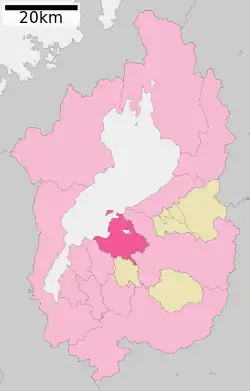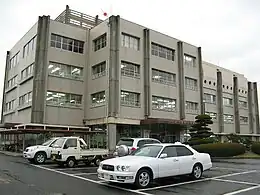Ōmihachiman
Ōmihachiman (近江八幡市, Ōmihachiman-shi) is a city located in Shiga Prefecture, Japan. As of 31 August 2021, the city had an estimated population of 82,233 in 34747 households and a population density of 570 persons per km2.[1] The total area of the city is 76.97 square kilometres (29.72 sq mi).
Ōmihachiman
近江八幡市 | |
|---|---|
 Old city view from Mt. Hachiman | |
 Flag  Seal | |
 Location of Ōmihachiman in Shiga Prefecture | |
 Ōmihachiman Location in Japan | |
| Coordinates: 35°07′42″N 136°5′53″E | |
| Country | Japan |
| Region | Kansai |
| Prefecture | Shiga Prefecture |
| Government | |
| • Mayor | Osamu Konishi <小西 理> (from April 2018) |
| Area | |
| • Total | 177.45 km2 (68.51 sq mi) |
| Population (31 August 2021) | |
| • Total | 82,233 |
| • Density | 460/km2 (1,200/sq mi) |
| Time zone | UTC+09:00 (JST) |
| City hall address | 236 Sakuragi-chō, Ōmihachiman-shi, Shiga-ken 523-8501 |
| Phone number | 0748-33-3111 |
| Website | Official website |
| Symbols | |
| Flower | Salvia |
| Tree | Azalea, Sakura |


Geography
Ōmihachiman is located in central Shiga Prefecture, on flatlands along the eastern shore of Lake Biwa, and extending inland to the foothills of the Suzuka Mountains.
Climate
Ōmihachiman has a Humid subtropical climate (Köppen Cfa) characterized by warm summers and cool winters with light to no snowfall. The average annual temperature in Ōmihachiman is 14.7 °C. The average annual rainfall is 1602 mm with September as the wettest month. The temperatures are highest on average in August, at around 26.6 °C, and lowest in January, at around 3.7 °C.[2]
Demographics
Per Japanese census data,[3] the population of Ōmihachiman has recently plateaued after several decades of growth.
| Year | Pop. | ±% |
|---|---|---|
| 1950 | 54,461 | — |
| 1960 | 52,756 | −3.1% |
| 1970 | 52,171 | −1.1% |
| 1980 | 70,772 | +35.7% |
| 1990 | 77,730 | +9.8% |
| 2000 | 78,669 | +1.2% |
| 2010 | 81,738 | +3.9% |
| 2020 | 81,122 | −0.8% |
History
Ōmihachiman is part of ancient Ōmi Province and was originally a post station that developed around Musa-juku on the Tōsandō (later the Nakasendō) highway connecting Heian-kyō with the eastern provinces. During the Sengoku period, the warlord Oda Nobunaga built Azuchi Castle in the hills on the border with Higashiōmi. Under Toyotomi Hidetsugu the center shirted to a castle town at the base of Hachimanyama Castle, which attracted many merchants ("Ōmi shōnin"), especially after the destruction of Azuchi Castle. Former merchant's residences and a canal used for transport are preserved in an old city area, designated a Preservation District for Groups of Traditional Buildings[4] and an Important Cultural Landscape.[5]
The town of Hachiman was established with Gamō District, Shiga with the creation of the modern municipalities system on April 1, 1889. In 1905, an American architect William Merrell Vories came to Ōmihachiman as an English language teacher at commercial high school. Two years later he resigned the original work, but he remained in Ōmihachiman and spent most of his productive life here. He handed down western-style buildings, a pharmaceutical company, an educational foundation and a hospital to the city. The town expanded by annexing the neighboring villages of Utsuro in 1933 and Shima in 1951. On March 31, 1954, Hachiman merged with the villages of Okayama, Kanada, Kirihara and Mabuchi to form the city of Ōmihachiman. The name was changed from "Hachiman" to "Ōmihachiman" to avoid confusion with the then existing city of Yahata in Fukuoka Prefecture, as both "Hachiman" and "Yawata" are written in the same kanji characters. On March 21, 2010, the town of Azuchi was merged into Ōmihachiman.
Government
Ōmihachiman has a mayor-council form of government with a directly elected mayor and a unicameral city council of 24 members. Ōmihachiman contributes three members to the Shiga Prefectural Assembly. In terms of national politics, the city is part of Shiga 4th district of the lower house of the Diet of Japan.
Economy
Agriculture, commercial fishing and seasonal tourism are major components of the economy of Ōmihachiman. The key industries of Ōmihachiman include the manufacturing of pharmaceuticals.
Education
Ōmihachiman has 12 public elementary schools and four public middle schools operated by the city government and three high schools operated by the Shiga Prefectural Department of Education. The city also has one private elementary school, one private middle school and one private high school.
Transportation
Railway
Sister cities [6]
Within Japan
Outside Japan
 Leavenworth, Kansas, United States, sister city, since 1997
Leavenworth, Kansas, United States, sister city, since 1997 Grand Rapids, Michigan, United States, friendship city, since 1986
Grand Rapids, Michigan, United States, friendship city, since 1986.svg.png.webp) Miryang, Gyeongsangnam-do, South Korea, friendship city, since 1994
Miryang, Gyeongsangnam-do, South Korea, friendship city, since 1994 Mantua, Lombardy, Italy, friendship city, since 2005
Mantua, Lombardy, Italy, friendship city, since 2005
Places of interest
Hachiman area
- Himure Hachiman-gū - The largest shrine in Ōmihachiman and the origin of the city name "Hachiman".
- Sagichō Festival - A fire festival in every March which is held in the old city area and the Himure Hachimangū.
- Hachimanyama Castle - Toyotomi Hidetsugu's castle. Hachimanyama Ropeway services between the mountaintop and Himure Hachimangū.
- Hachiman-bori canal
- Suigō meguri - In the northeast of the city central, sightseeing boats service through the rural lagoon.
- Kawara Museum
- Dainaka Lake Minami Site, Yayoi period settlement trace, National Historic Site
- Lake Biwa
- Okishima - A fishing island which is the only inhabited lake island in Japan.
- Isaki no Sao-tobi - A water festival in every August which tests men's courage to jump into the lake from the Isaki Temple.
- Musa-juku
Azuchi area
- Azuchi Castle, Special National Historic Site
- Kannonji Castle ruins, National Historic Site
- Chōmei-ji, 31st temple of the Saigoku Kannon Pilgrimage (西国三十三箇所, Saigoku sanjūsankasho)
- Kannonshō-ji, 32nd temple of the Saigoku Kannon Pilgrimage (西国三十三箇所, Saigoku sanjūsankasho)
- Yukinoyama Kofun, National Historic Site
- Azuchi-Hyōtanyama Kofun, National Historic Site
- Oiso Shrine, National Historic Site
Notable people
- Kota Aoki, football player
- Takashi Inui, football player
- Tatsuo Kawabata, politician
- Miku Tanabe, entertainer
- Kazuyo Matsui, actress
- Rorochan_1999 (1999–2013), died aged 14 while livestreaming, and notable subject of internet suicide.
References
- "Ōmihachiman city official statistics" (in Japanese). Japan.
- Ōmihachiman climate data
- Ōmihachiman population statistics
- "Database of Registered National Cultural Properties". Agency for Cultural Affairs. Retrieved 6 September 2011.
- "Database of Registered National Cultural Properties". Agency for Cultural Affairs. Retrieved 29 April 2011.
- Ōmihachiman official home page
External links
- Ōmihachiman City official website (in Japanese)
- Ōmihachiman Tourism Association (in Japanese)